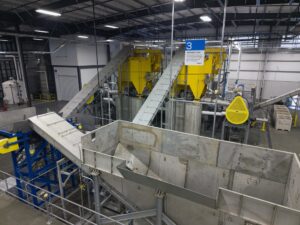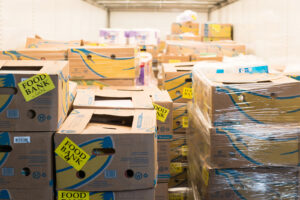May 27, 2025
In this blog post: The Risks of Unsecure Diversion | What is Certified Destruction | The Best Destruction Method for Industrial Food Waste | How to Vet Potential Diversion Vendors | Diversion You Can Trust
Summary: In the food industry, brand integrity, food safety, and compliance are paramount. This blog outlines the risks of unsecured diversion of industrial wasted food and offers guidance for industrial food companies on what to look for in a diversion solution to ensure security, compliance, and sustainability.
As landfills inch toward capacity and regulatory pressure mounts, industrial food companies are facing a critical challenge: how to sustainably divert wasted food and food byproducts from the landfill without compromising brand integrity. While some diversion methods may offer short-term fixes, they often leave companies exposed to misuse, liability, and reputational risk. To meet regulatory expectations and sustainability goals as well as operational demands, today’s leaders need secure waste diversion solutions that go beyond compliance—and protect their business at every step.
This blog outlines the risks of unsecured diversion, what the key components of secure diversion are, and how to vet potential diversion partners to ensure certified destruction of your organic material.
The Risks of Unsecured Diversion
In the food industry, brand integrity, food safety, and compliance are paramount. Choosing a diversion solution that isn’t secure can carry significant risks:
- Your product isn’t destroyed and ends up back on the market as an unauthorized resale
- A recalled product makes it to the end consumer through an unauthorized resale, posing a health risk for them and a liability for you
- Your product is destroyed, but your packaging isn’t, signaling to onlookers that you had a recall event
- Failure to comply with regulations and record keeping of destruction events
To avoid these risks, industrial food companies need more than just sustainable diversion—they need documented, verifiable processes. That’s where certified destruction comes in. But what exactly does that entail, and why is it so essential?
What Certified Destruction Really Means
Certified destruction demands a comprehensive approach that addresses not only the organic material, but also the packaging it’s contained in, and the broader business sensitivities involved:
- Complete mechanical destruction of packaging through a multi-step process so that by the end, packaging is unidentifiable, commingled, and irreversibly destroyed.
- Complete destruction of organic content that recovers as many nutrients as possible for beneficial use.
- Secure facilities with monitored access to protect your material.
- Documentation that traces chain of custody and provides photo and video evidence as well as certificates of disposal.
- Regulatory compliance with local, state, and federal laws and policies.
With the right processes and technology, you can not only gain proof of destruction but measurable impact against regulatory expectations and sustainability goals.
Choosing the Right Destruction Method for Your Products
Choosing the right organics processing method to process your material is key to achieving secure destruction. Not all waste diversion methods are created equal.
Industrial food waste is a complex mixture of food products, byproducts, liquids, and slurries. The appropriate solution must be able to handle this complex mixture and recover most of its nutrients and energy potential for beneficial use. Anaerobic digestion, a biological process that occurs naturally in marshes and swamps, can transform food products and byproducts into renewable natural gas and soil enhancements in a sealed container. Anaerobic digestion is better able to handle the high moisture content of industrial waste and put nearly 100% of the organic material to beneficial use, but the same cannot be said of compost.
Depackaging technology is another crucial component of effective diversion that can have several benefits:
- It can save time and labor, freeing up your team to focus on your core business.
- It can prevent brand and legal risks.
- It can reduce the risk of microplastics contamination in soil amendments and renewable natural gas because it effectively separates but does not shred packaging from food products.
How to Vet Potential Diversion Vendors
Certified destruction is the bridge between brand security, compliance, and sustainability. With the right vendor, you’ll have peace of mind that:
- You can control your brand, even when your unsold food products and byproducts leave your facility.
- You can have verifiable proof that your material is being securely and sustainably destroyed.
- You have the right tools for compliance with local regulations.
- You can achieve a sustainable impact.
Here are key questions you should ask potential vendors to ensure they meet your standards for security, compliance, and brand protection:
- What types of food and beverage material do you accept? (Make sure they accept all or most of the products in your portfolio, including product recalls, expired or contaminated loads, beverage waste, and bulk liquids.)
- How are unsold food products depackaged?
- Do you provide secure transport if needed?
- Who has access to manage your food material?
- How is product destruction verified and documented? What forms of proof can you consistently provide (e.g., chain of custody, video and photo evidence, certificates of disposal)?
- How do you manage and document compliance with local regulations?
- How do you track sustainable impact?
Waste Diversion You Can Trust
At Divert, we know how important your brand reputation is to your business. Our plants, people, and processes support the confidential, certified destruction of food products and byproducts at scale. It’s why the nation’s leading food companies trust us to handle their waste.
We guarantee:
- Certified & verified product destruction
- Performed in a secure environment
- Support of your regulatory compliance goals
As your partner in regulatory compliance, we accept a wide range of industrial food products and byproducts, including:
- Fully packaged and palletized food & beverage
- Raw, intermediate, and finished goods in any format
- Off-spec, damaged, expired, and contaminated product
- Recalled product requiring regulatory oversight
- Bulk and containerized liquids
- DAF/SAF sludges
For more information about our secure diversion solutions for industrial food waste, click here:



